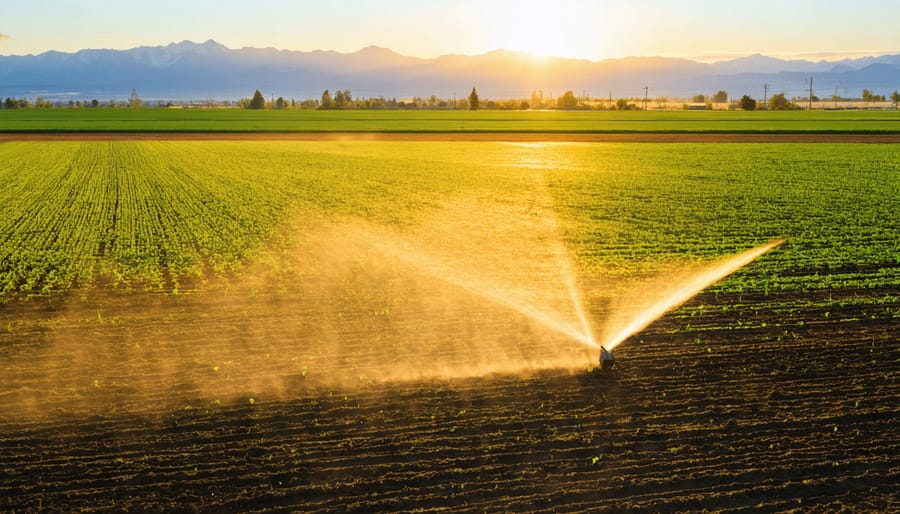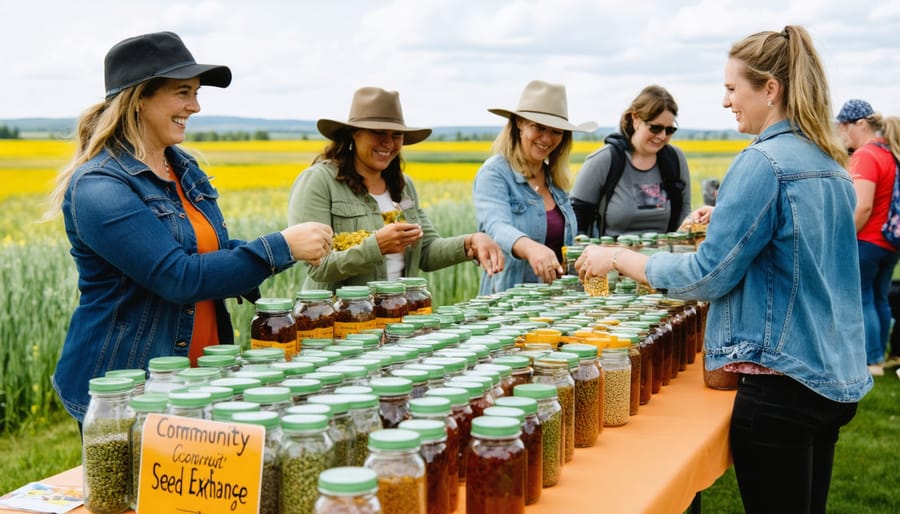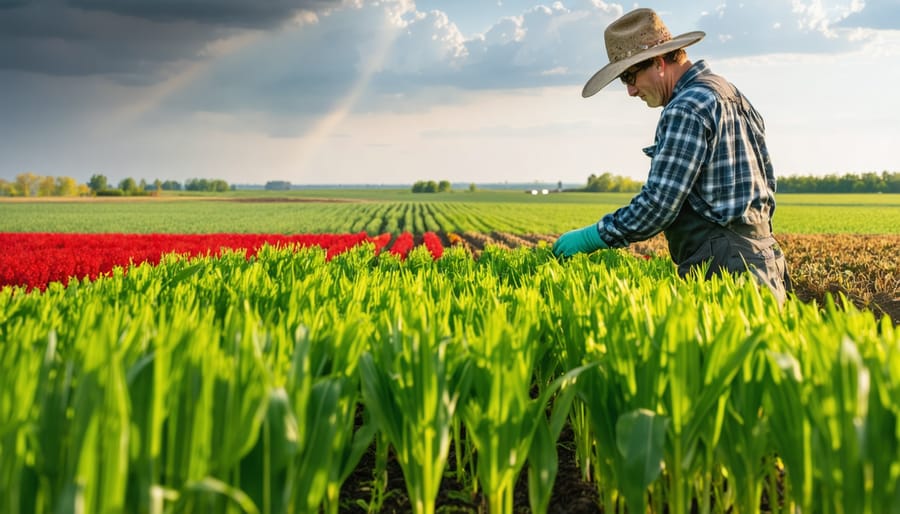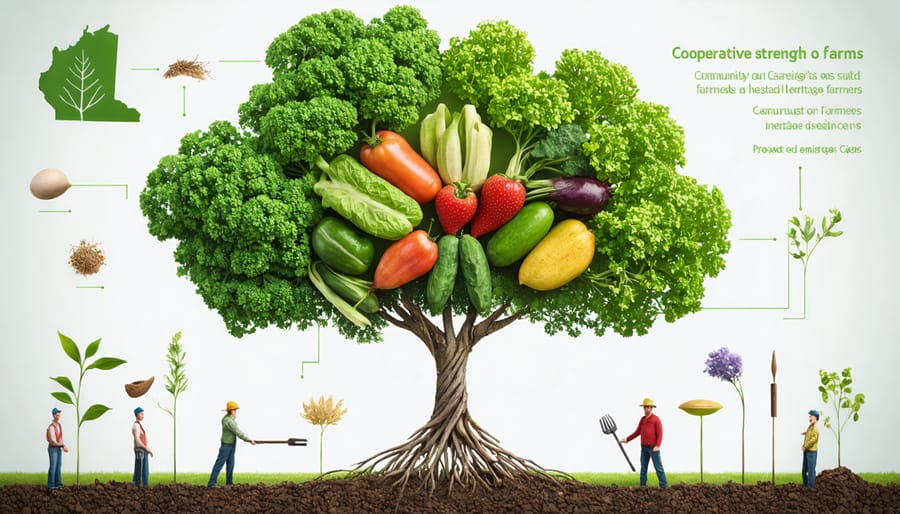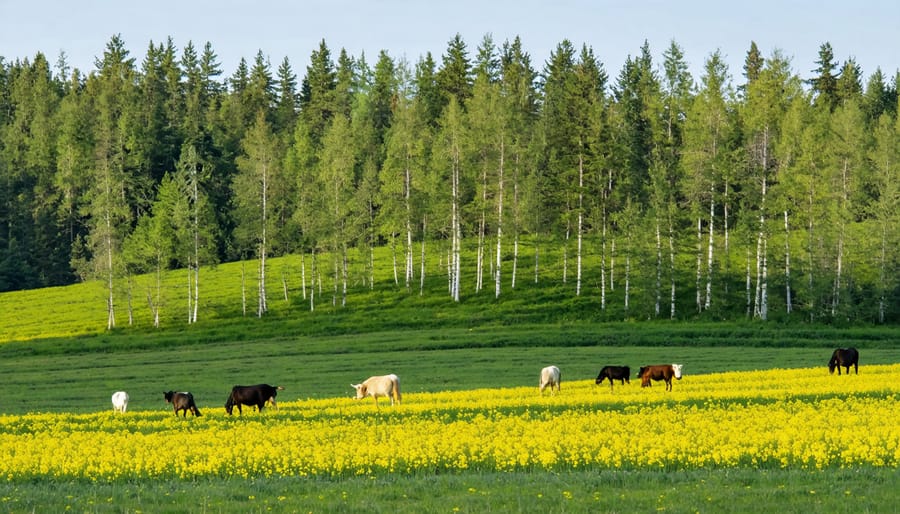Experimental seed networks are transforming Canadian agriculture, one heritage variety at a time. From Peace Country’s ancient grain collectives to Southern Alberta’s indigenous seed preservation projects, these grassroots initiatives are building resilient food systems while preserving our agricultural heritage. In 2023, over 200 Alberta farmers joined local seed networks, exchanging more than 1,500 distinct crop varieties and strengthening regional food security.
These collaborative networks do more than just preserve genetic diversity—they’re creating living laboratories where farmers share knowledge, adapt to climate challenges, and maintain seed sovereignty. Through structured seed trials, careful documentation, and peer-to-peer learning, participants are developing locally-adapted varieties that thrive in specific microclimates across the province.
The impact extends beyond individual farms. Experimental seed networks are becoming crucial hubs for agricultural innovation, connecting traditional farming wisdom with modern sustainable practices. As weather patterns become less predictable and input costs rise, these networks offer practical solutions for farmers seeking to build more resilient and independent operations.
Join the movement that’s redefining agricultural sustainability in Alberta. Whether you’re a seasoned farmer or market gardener, participating in an experimental seed network opens doors to rare varieties, valuable knowledge exchange, and a supportive community of forward-thinking growers.
The Power of Community-Based Seed Sharing
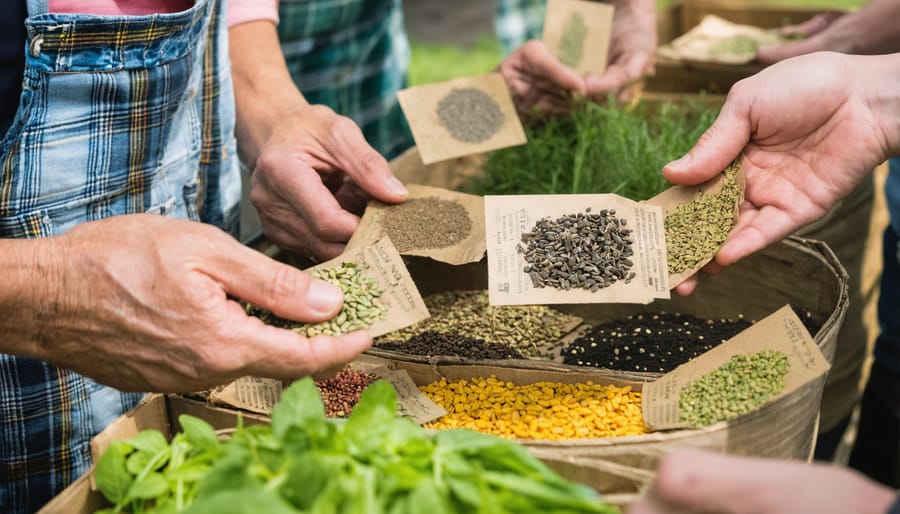
Building Local Seed Resilience
Local seed networks play a vital role in building resilient food systems by preserving and developing regionally adapted crop varieties. In Alberta, these networks have become increasingly important as farmers seek to maintain genetic diversity while adapting to local growing conditions and climate challenges.
By saving and sharing seeds that thrive in specific regions, farmers create a robust foundation for local food security. These adapted varieties often demonstrate better resistance to local pests, diseases, and weather patterns, reducing the need for external inputs and increasing crop reliability.
Communities participating in seed networks report significant improvements in crop diversity. For example, the Prairie Heritage Seed Network has documented over 200 locally adapted varieties, including cold-hardy wheat strains and drought-resistant legumes specific to Alberta’s growing conditions.
The strength of local seed networks lies in their collaborative nature. When farmers pool their knowledge and resources, they create a living seed bank that preserves traditional varieties while developing new ones suited to changing environmental conditions. This community-based approach ensures that valuable genetic resources remain accessible to future generations of Canadian farmers.
Economic Benefits for Alberta Farmers
Participating in experimental seed networks can create substantial economic opportunities for Alberta farmers through multiple channels. By sharing and exchanging seeds within the network, farmers can significantly reduce their input costs, sometimes by as much as 40% compared to purchasing commercial seeds annually. Many network members report saving $2,000 to $5,000 per growing season on seed expenses alone.
Beyond cost savings, these networks open doors to specialty market opportunities. Farmers can access and grow unique heritage varieties that command premium prices at farmers’ markets and through direct-to-consumer sales. Network participants have reported earning 25-35% higher returns on specialty crops grown from shared seeds compared to conventional varieties.
The collaborative nature of seed networks also reduces risk through crop diversification. When farmers can easily access multiple varieties, they’re better positioned to adapt to changing market demands and environmental conditions. Additionally, the knowledge-sharing component helps members identify profitable niches and marketing strategies, leading to more sustainable long-term income streams. Many Alberta farmers have successfully transitioned portions of their operations to higher-value crops through network connections and shared expertise.
Setting Up Your Local Seed Network
Essential Infrastructure
A successful experimental seed network requires carefully planned infrastructure to maintain seed viability and facilitate efficient distribution. The foundation starts with a climate-controlled storage facility maintaining temperatures between 5-10°C and relative humidity of 30-40%. These facilities should be equipped with adjustable shelving systems and airtight containers to protect seeds from moisture and pests.
Essential equipment includes precision scales for weighing and portioning seeds, seed cleaning equipment such as screens and winnowers, and proper labelling supplies. A dedicated processing area with adequate workspace and proper ventilation is crucial for seed cleaning and packaging operations.
For Alberta’s climate, backup power systems are vital to maintain consistent storage conditions during extreme weather events. Digital monitoring systems help track temperature and humidity fluctuations, while inventory management software assists in maintaining accurate records of seed varieties and quantities.
Distribution infrastructure should include proper packaging materials, shipping supplies, and a designated area for order fulfillment. Many successful networks in Alberta also maintain a small laboratory space for basic germination testing and quality control measures. A meeting room or educational space supports community engagement and training activities, essential for network sustainability.

Documentation and Record-Keeping
Maintaining detailed records is crucial for the success of any experimental seed network. Create a comprehensive digital database or physical logbook that tracks essential information for each seed variety, including planting dates, harvest yields, and performance characteristics. Document growing conditions, pest resistance, and any unique traits observed during cultivation.
For quality assurance, implement a standardized labeling system that includes variety names, collection dates, and storage conditions. Photos of plants at different growth stages can provide valuable visual references. Keep detailed notes on seed cleaning methods, germination tests, and storage protocols.
Many Alberta farmers use simple spreadsheet templates or specialized farm management software to track their seed inventory. Consider maintaining backup copies of all documentation and sharing standardized record-keeping formats within your network. This helps ensure consistency and makes it easier to exchange information with other participants.
Regular updates to your records, particularly noting successful growing techniques and challenges encountered, create a valuable knowledge base for future seasons and help maintain the network’s integrity. Remember to include contact information for seed sources and any relevant certification details.
Building Your Network
Building a strong experimental seed network starts with connecting to your local agricultural community. Begin by reaching out to established farming organizations like the Alberta Organic Producers Association and regional agricultural societies. These grassroots community initiatives often maintain extensive networks of farmers interested in seed sharing and experimentation.
Consider attending local agricultural fairs, seed swaps, and farmer meetups where you can meet potential network partners face-to-face. The Alberta Farm Fresh Producers Association hosts regular events that provide excellent networking opportunities. Social media platforms, particularly Facebook groups and LinkedIn, can help you connect with farmers beyond your immediate geographical area.
Don’t overlook the value of agricultural extension offices and research stations. These institutions often maintain databases of local farmers and can facilitate introductions. Additionally, joining seed-saving workshops and agricultural workshops can help you meet like-minded individuals while building your knowledge base.
Remember to maintain regular communication with your network through newsletters, seasonal meetups, or online forums to keep the community engaged and active.
Success Story: The Red Deer Valley Seed Collective
The Red Deer Valley Seed Collective emerged in 2018 as a shining example of community-powered agricultural solutions in Central Alberta. What began with just eight farmers sharing heritage wheat varieties has grown into a network of over 60 active members spanning three counties.
The collective’s success stems from its innovative approach to seed preservation and distribution. Members collaborate to grow, harvest, and share climate-adapted varieties of grains, pulses, and vegetables suited to Alberta’s unique growing conditions. Their focus on cold-hardy varieties and drought-resistant crops has proven particularly valuable as weather patterns become increasingly unpredictable.
Sarah Thompson, one of the founding members, explains: “We’ve created a living seed bank that responds to our local needs. Last year, when late spring frosts affected many farms, our members had access to short-season alternatives that could still produce a viable crop.”
The collective operates through a sophisticated but accessible system. Each member commits to growing at least one variety for seed saving and participates in quality control measures. They maintain detailed records of growing conditions, yields, and performance characteristics, creating a valuable database for regional farming practices.
Their seed library now houses over 200 varieties, including rare heritage grains like Red Fife wheat and Purple Prairie barley. The network has established partnerships with agricultural research stations and local agricultural societies, facilitating knowledge exchange and variety testing.
Perhaps most importantly, the collective has built a sustainable model for seed sovereignty. Members pay modest annual fees that support infrastructure and testing costs, while excess seeds are sold to local markets, generating revenue for expansion. Their success has inspired similar initiatives across Alberta, demonstrating how local seed networks can strengthen regional food security while preserving agricultural biodiversity.
Best Practices for Seed Preservation
Storage Conditions
Proper storage conditions are crucial for maintaining seed viability within experimental seed networks. Seeds should be kept at temperatures between 5°C and 10°C, with relative humidity levels maintained at 30-40%. For most Alberta farmers, a dedicated space in an insulated garage or basement often provides suitable conditions during our cold winters.
Store seeds in airtight, food-grade containers made of glass or high-quality plastic. Mason jars work exceptionally well, especially when fitted with rubber gaskets to ensure a proper seal. For smaller quantities, coin envelopes placed inside larger containers help organize different varieties while preventing cross-contamination.
Include silica gel packets or powdered milk in storage containers to absorb excess moisture. Replace these desiccants annually during your spring inventory check. Label each container with essential information including variety name, collection date, and source location.
Monitor storage areas regularly for temperature fluctuations using a basic thermometer-hygrometer combination unit. Many local seed savers in Alberta have found success using root cellars, which naturally maintain consistent cool temperatures year-round.
For long-term storage, consider using a dedicated mini-fridge set to 7°C. While this requires a small investment, it significantly extends seed viability, particularly for heritage varieties that may be difficult to replace. Remember to keep seeds away from direct sunlight and areas prone to temperature swings, such as exterior walls or heating vents.
Quality Control Methods
Quality control in experimental seed networks requires rigorous testing and monitoring to maintain seed purity and viability. Network participants follow standardized protocols that begin with careful documentation of seed sources and growing conditions. Seeds undergo germination testing in controlled environments, typically maintaining temperatures between 20-25°C, with results recorded after 7-14 days depending on the crop variety.
Physical purity testing involves examining seed samples for unwanted materials, damaged seeds, and potential cross-contamination. Alberta seed growers commonly use specialized equipment like air screen cleaners and gravity tables to separate quality seeds from debris. Regular moisture content testing ensures seeds maintain optimal levels between 8-14%, preventing premature deterioration during storage.
Disease screening is particularly crucial in our climate. Seeds are tested for common pathogens using both visual inspection and laboratory analysis. Many Alberta seed networks partner with regional agricultural labs for comprehensive disease testing services.
To maintain genetic purity, isolation distances between different varieties of the same crop are strictly enforced. For example, wind-pollinated crops require larger isolation distances, often 200-400 metres, while self-pollinating crops may need only 10-20 metres of separation.
Documentation plays a vital role in quality control. Network members maintain detailed records of growing conditions, harvest dates, cleaning procedures, and test results. This information helps trace any issues that arise and supports continuous improvement of seed quality standards within the network.

Legal and Regulatory Considerations
In Canada, seed sharing networks operate within specific regulatory frameworks designed to protect agricultural biodiversity and ensure seed quality. The Seeds Act and Seeds Regulations establish guidelines for seed distribution, while allowing certain exemptions for small-scale and experimental initiatives.
For Alberta farmers participating in experimental seed networks, it’s important to note that sharing seeds for research and preservation purposes is generally permitted. However, if you plan to sell or commercially distribute seeds, you’ll need to comply with the Canadian Food Inspection Agency (CFIA) requirements, including variety registration and quality testing.
Small-scale seed exchanges between farmers are typically exempt from commercial regulations, provided they’re conducted for non-commercial purposes. This creates opportunities for community-based seed preservation while maintaining regulatory compliance.
When preserving heritage varieties, documentation is crucial. Keep detailed records of seed origins, growing conditions, and selection criteria. This information not only helps maintain seed quality but also supports compliance with traceability requirements.
For indigenous seed varieties, additional considerations apply under the Indigenous Agricultural Strategy, which recognizes traditional seed-keeping practices and knowledge systems.
Local agricultural extension offices can provide guidance on specific regulatory requirements and exemptions. It’s recommended to consult with these offices when establishing or joining an experimental seed network to ensure all activities align with current regulations while supporting sustainable agricultural practices.
Experimental seed networks represent a vital cornerstone of agricultural resilience and community building in Canada. By participating in these networks, Alberta farmers gain access to diverse, locally-adapted seed varieties while contributing to the preservation of our agricultural heritage. The benefits extend beyond individual farms, creating stronger regional food systems and fostering innovation through shared knowledge and resources.
The success stories from across Alberta demonstrate how these networks have helped farmers reduce input costs, improve crop resilience, and develop unique market opportunities. Whether you’re an experienced farmer or just starting out, joining an experimental seed network offers invaluable opportunities for learning, collaboration, and growth.
We encourage you to take the first step by connecting with local seed saving groups, attending community seed exchanges, or reaching out to experienced network members in your area. Your participation not only strengthens your own farming operation but also contributes to a more sustainable and resilient agricultural future for all Canadians.
Remember, every seed shared and every connection made helps build a more robust and independent farming community. The future of Canadian agriculture depends on our collective efforts to preserve, improve, and share our seed resources.


